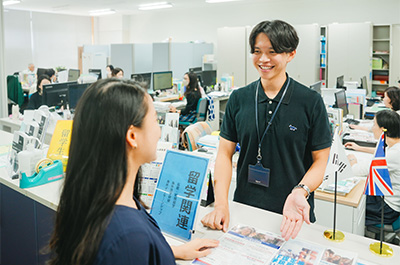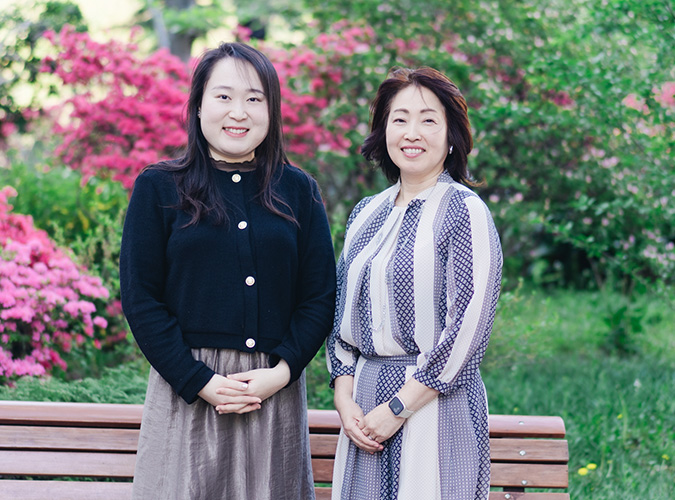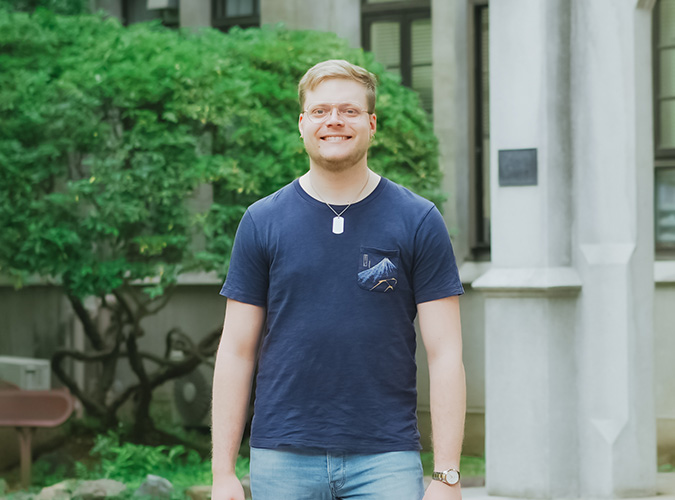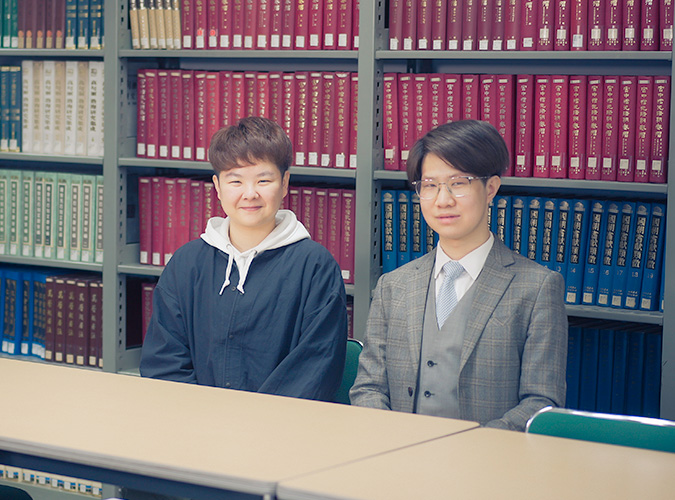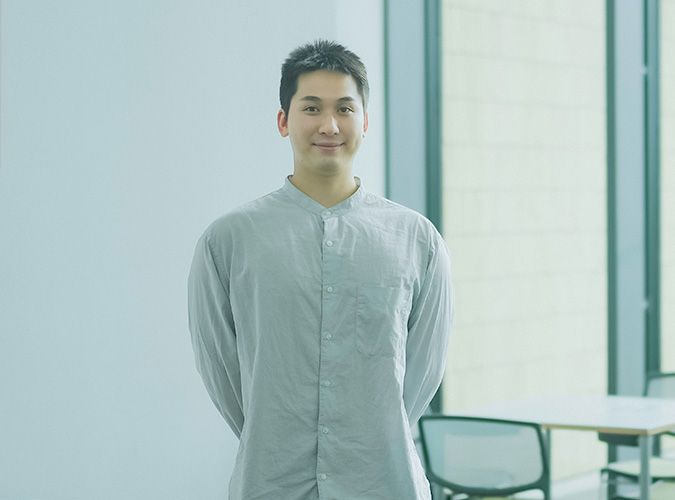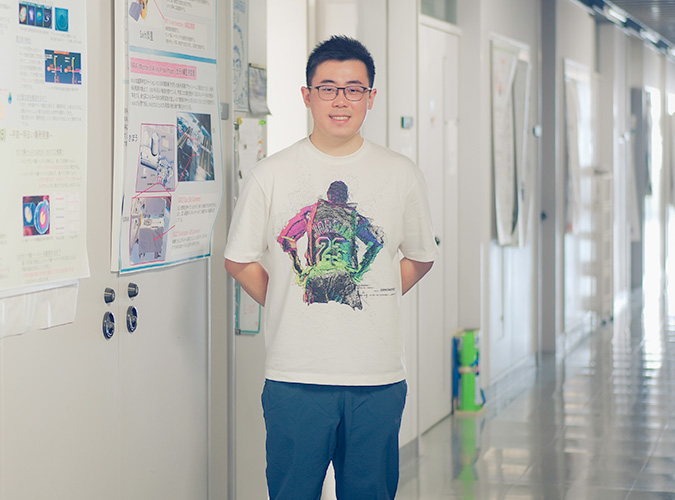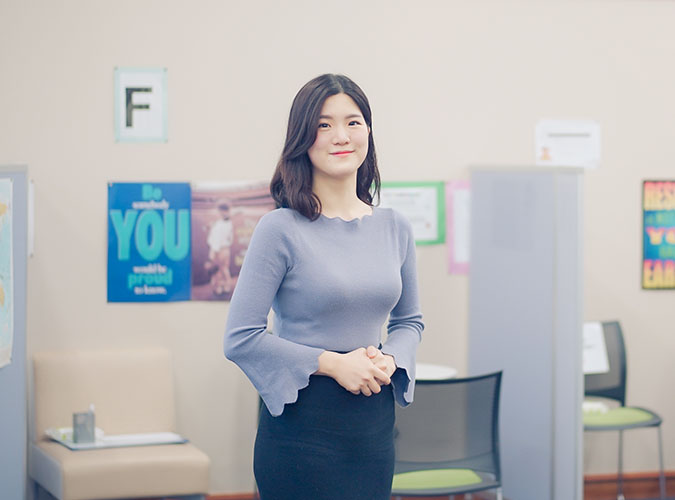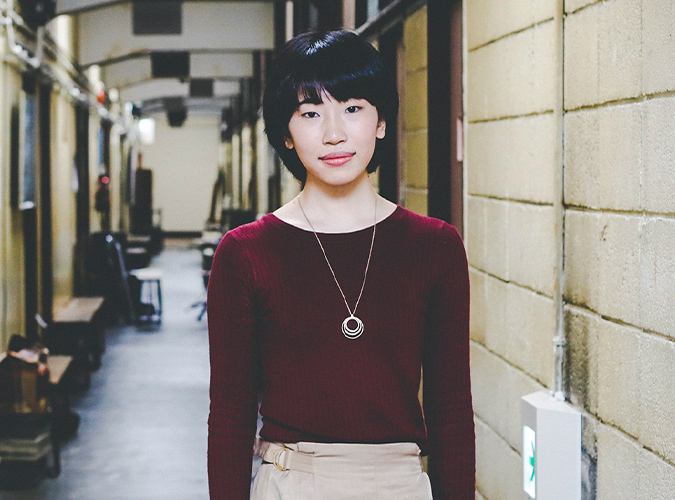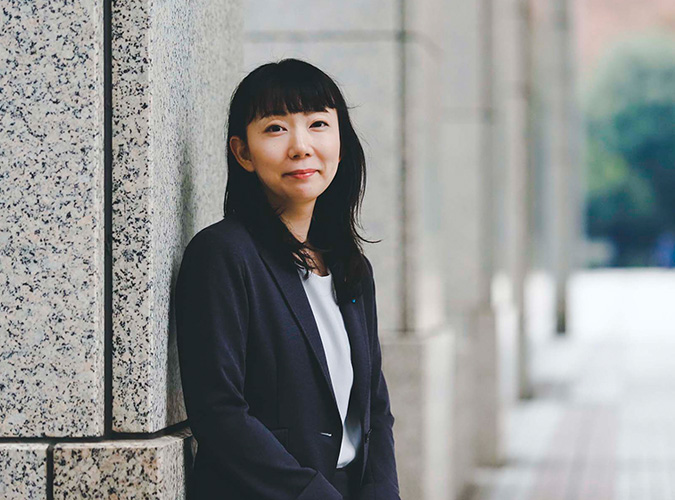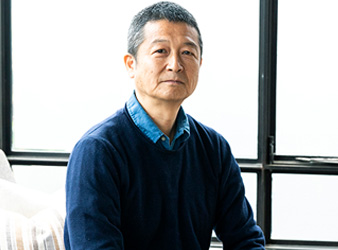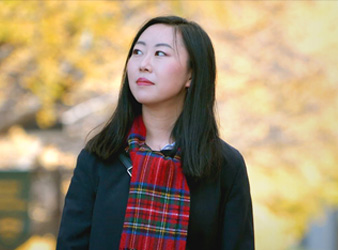Forging a New Path Between Languages and Cultures

OVERTURE
Studying Japanese philology at Ukraine’s Taras Shevchenko National University of Kyiv, Karina found herself drawn to the intricacies of the Japanese language and its rich cultural heritage. Having developed a background in translation and appreciation for Japanese literature, Karina embarked on a journey to study at Aoyama Gakuin University to deepen her first-hand understanding of Japan. Her time in Tokyo has offered her not just academic growth, but valuable perspectives on work-life balance and personal development.
Sowing seeds of a deep linguistic and cultural fascination
My initial interest in Japanese language emerged when I was younger, sparked by an appreciation for how the language sounded in anime shows that I watched. At the time, opportunities to study Japanese were limited in my hometown, and online language schools weren’t yet widely available. Still, my curiosity about East Asian languages and cultures continued to grow.
During my school years, I found myself naturally drawn to language studies, particularly excelling in English. As I approached university age, I knew I wanted to pursue something beyond Western languages, but I needed to choose a direction that would align with both my interests and future career prospects. The choice ultimately came down to Korean or Japanese studies, and though my focus is Japanese, my major actually includes both.
It was my father who suggested pursuing Japanese studies, recognizing my interest in the language and culture. Though I only knew basic greetings and words picked up from various media content before starting university, the idea of diving deep into Japanese studies resonated with me. At the time, I couldn’t have imagined that this decision would lead me not only towards a deep understanding of the language but also to discovering my passion for translation.
Before starting my university studies, I attempted some self-study of Japanese but quickly realized that learning such a distinct language system required more structured guidance. Unlike Western languages that share similar alphabets and grammatical concepts, Japanese demanded a different approach to learning. This early recognition of the language’s complexity heightened my interest in pursuing formal studies.

A foundation of Japanese expertise accumulated in Ukraine
The Institute of Philology at Taras Shevchenko National University of Kyiv offers a unique environment for Japanese language study. Unlike university programs that allow students to choose their classes, our curriculum follows a fixed structure, with approximately 30 students per year following a carefully designed progression of language and cultural studies. This system created a close-knit community among students and professors, fostering a deep affinity that enhanced our learning experience.
Our program is comprehensive, covering not just language acquisition but a deep dive into various aspects of Japanese studies. The curriculum includes Japanese grammar and language skills, literature, history, customs, traditions, and culture. In our third year, we face a pivotal choice between focusing on translation or diplomacy—I chose the translation track.
The translation component of our studies was particularly rigorous. We practiced various types of translation, each presenting its own unique challenges and learning opportunities. Commercial translation, which I initially approached with uncertainty, became one of my favorite aspects of the program. The creative thinking required to effectively convey marketing messages across cultural boundaries proved both challenging and engaging. Government-related translation work took on special significance given current events in Ukraine, as we learned to handle official documents and news content with precision and sensitivity.
We also had opportunities to practice interpretation—a challenging but rewarding experience that tested my skills by having to listen to another language and reproduce it in Ukrainian in real-time. The program’s approach to literature was also thorough, with studies focused on classical works like the Manyoshu, but also on more modern Japanese literature. Dazai Osamu’s No Longer Human became a favorite of mine, and I enjoy translating novels and poetry myself, although poetry is very challenging to translate well.
Our teaching staff represented a mix of perspectives. Ukrainian professors who had studied or worked in Japan brought practical insights about navigating between the two cultures, while Japanese teachers provided native language exposure. I found that non-native speakers who have mastered Japanese can sometimes better explain certain aspects of the language, having personally experienced the learning process for Japanese themselves.
My school hosted cultural events, including visits from Korean and Japanese diplomats, ikebana flower arrangement workshops, and performances of traditional Japanese instruments. These events provided practical exposure to Japanese culture and helped us understand how our language skills could be applied in real-world situations. Also, our institute maintains strong connections with Japan through various partnerships and exchange programs.
Making AGU my bridge to Japanese culture
My connection to AGU first began last spring through a collaborative online class on Japanese literature between our universities. While it was limited to only two sessions, it provided an initial taste of what studying at AGU might be like. The first session focused on self-introductions and getting acquainted with the students assigned to our groups. In the second session, we introduced our favorite pieces of literature from either Japan or Ukraine. These interactions, though brief, gave me a glimpse of the academic environment at AGU.
When it came time to choose a university for exchange, AGU was at the top of my list because of its excellent location, and the previous exposure to the university through the collaborative class made it an appealing choice. Additionally, the school has a great reputation which I learned about.
The academic experience at AGU has presented me with both challenges and opportunities for growth. The structure of the school day differs significantly from what I was used to in Ukraine—classes are longer, with extended breaks between them. While I would prefer shorter breaks and earlier finish times, this schedule has made me adapt my study habits and time management. Another significant adjustment has been adapting to the strict adherence to punctuality in Japanese culture. In Ukraine, professors typically maintain a flexible approach, particularly given current circumstances where students might face challenges like power outages or air raid sirens. In Japan, tardiness is not accepted, and deadlines are firm, so this difference has been a challenging one.
My course load at AGU includes Japanese language courses, Society and Culture of Japan L, Japanology B, and a Seminar in Japanese Literature Ⅱ [1]. The
literature seminar has proven particularly challenging as it’s a regular course conducted in
Japanese. I’m the only student who is not fully fluent in Japanese in the class. While
specialized vocabulary and classical texts present obstacles, the immersion has dramatically
improved my listening comprehension and ability to grasp meaning based on context even when
I miss specific words.
The seminar culminated with my research presentation on “Themes of Feminism in 19th-20th Century Literature – A Comparison of Works by Akiko Yosano and Olha Kobylianska,” which I delivered entirely in Japanese. Following my presentation, Professor Komatsu and my fellow classmates told me that they were impressed by my research and learned a lot from it. Hearing such feedback from them was a deeply moving moment for me.
 Professor Komatsu (back row, right) with
seminar classmates (Karina in the center of the front row)
Professor Komatsu (back row, right) with
seminar classmates (Karina in the center of the front row)
The approach to Japanese language instruction here differs notably from my experience in Ukraine. Rather than the structured, grammar-focused lessons I was accustomed to, classes here emphasize conversation and reading diverse materials. While this approach has its merits in developing practical communication skills, I sometimes miss the systematic approach back home. To maintain my growth in this area, I’ve kept up with grammar study on my own, particularly when I was preparing for the Japanese Language Proficiency Test (JLPT) N2 exam.
Finding serenity away from the urban bustle
Life in Tokyo has challenged many of my preconceptions about Japan. Before arriving, I worried that Japanese people might be reserved or reluctant to engage with people from abroad. Instead, I’ve encountered many people eager to converse, particularly those interested in international exchange or learning about life outside Japan. These interactions have often led to engaging conversations in both Japanese and English, allowing me to practice language while sharing perspectives about our respective cultures.
The Tokyo metropolitan area reveals different characteristics depending on where you are. While Shibuya can be visually overwhelming with its dense advertising and crowds, I’ve found myself drawn to Shinjuku’s energy and Yokohama’s calmer pace. The Sky Garden in Yokohama Landmark Tower's 69th floor is a favorite of mine, offering panoramic views that can extend to Mount Fuji on clear days, without the crowds and at a more reasonable price than Tokyo’s popular observation decks. Also, the Minato Mirai area is another place where you can relax with some greenery, and I have even happened upon festivals and street performers there.
 Night view from Yokohama Landmark Tower
Night view from Yokohama Landmark Tower
Needing to commute to school in the center of the city, the complexity of Tokyo’s train system initially seemed overwhelming, and the rush hour crowds can still be uncomfortable. However, I’ve discovered ways to find tranquility within the urban environment. Evening walks by Tokyo Bay or nearby riverbanks offer peaceful moments of reflection.
I recently joined a group of fellow exchange students for a day trip to Nikko, having an opportunity to explore a more rural and nature-rich area. The mountainous landscape and waterfalls reminded me of the mountain trips I used to take with my family back in Ukraine. I also enjoyed experiencing my first snow in Japan during the trip. Excursions like this help balance the urban intensity of Tokyo life. During the next holiday, I’m planning to explore more of Japan with a trip to Osaka and the Kansai region, where I’m eager to experience the city’s famous vitality and atmosphere.
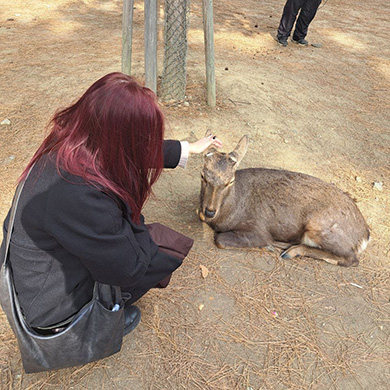 Interacting with the deer inhabiting Nara Park (a National Natural Monument of Japan)
Interacting with the deer inhabiting Nara Park (a National Natural Monument of Japan)
Weaving together a multilingual career trajectory
While studying at AGU, I’ve maintained my connection to Ukraine through teaching Japanese lessons to other Ukrainians online. Managing the seven-hour time difference means sometimes teaching until 2 AM at night, but the experience has been very rewarding. Before finding this opportunity, I did not imagine myself becoming a language teacher, but it has become a genuine source of enjoyment. Most of my students are older than me, bringing diverse perspectives and experiences to our lessons. Recently, one of my students successfully passed the JLPT exam, which was a moment of pride that confirmed the value of our shared efforts.
Especially in recent years, I have observed a significant shift in Ukraine’s engagement with Japanese culture. What was once a niche interest around 2015, when enjoying Japanese media and anime might have seemed unusual, has evolved into a mainstream phenomenon. Since around 2019, there has been a notable increase in Ukrainian-language content related to Japanese culture. New publishing houses specializing in Japanese literature have emerged, and official manga translations can now be found in regular bookstores throughout Ukraine.
This cultural shift has created growing opportunities for Japanese language specialists. However, with many Ukrainian Japanese specialists choosing to relocate to Japan, there’s a particular demand for professionals who can bridge these cultures from within Ukraine. While I enjoy working with Japanese people and culture, I envision my future role as contributing to this cultural exchange from home, particularly through literary and creative translation work.
Looking ahead, I plan to complete my education this coming summer in Ukraine, after which I will take a new step in my career. This experience at AGU has taught me valuable lessons about balance and personal growth. Before coming to Japan, I felt like this should be the best period of my life, but I came to realize that no matter where you are, you bring yourself with you—if you have something going on back home, it will still be going on even if you are in a different country. Being far from family and friends during Ukraine’s ongoing difficulties has been challenging, but it also helped me appreciate the importance of maintaining those connections back home.
The skills and perspectives I’ve gained at AGU will inform my future work, whether I’m translating books, teaching Japanese to Ukrainian students, or finding new ways to contribute to cultural understanding between the two countries. While before I could have only dreamed to come to Japan, and I have thoroughly enjoyed my time here, I realized that my most meaningful contribution might be in helping others bridge the cultural and linguistic gaps between these two countries that have shaped my academic and personal journey.

| MON | 2 11:00 a.m〜12:30 p.m | Japanese (ⅣF)A |
|---|---|---|
| 4 15:05 p.m〜16:35 p.m | Seminar in Japanese Literature Ⅱ [1] |
| TUE | 1 9:00 a.m〜10:30 a.m | Japanese (ⅣF)B |
|---|---|---|
| 2 11:00 a.m〜12:30 p.m | Japanology B | |
| 3 13:20 p.m〜14:50 p.m | Topics in Japanese Studies Ⅱ[in English] |
| WED | 2 11:00 a.m〜12:30 p.m | Japanese (ⅣF)C |
|---|
| THU | 2 11:00 a.m〜12:30 p.m | History of Media[in English] |
|---|---|---|
| 4 15:05 p.m〜16:35 p.m | English Studies E[in English] |
| FRI | 1 9:00 a.m〜10:30 a.m | Society and Culture of Japan L |
|---|---|---|
| 2 11:00 a.m〜12:30 p.m | Japanese (ⅣF)D |
Course




Aoyama Gakuin International Center
The role of the International Center (IC) at Aoyama Gakuin University is to provide educational support related to the internationalization of the university as well as to support the development of students to become global citizens. The main work of the IC consists of assisting both students going overseas and international students from overseas partner schools and approved institutions; as well as planning and operating intensive language training along with other programs and special events. The worldwide trend of globalization affects not only corporate activities and international relations, but should also impact the structure of university education and curricular content. With that in mind, the IC strives to strengthen and expand collaboration between overseas universities and Aoyama Gakuin University while respecting the diverse cultures and traditions of each country as well as the customs and values of our students.
